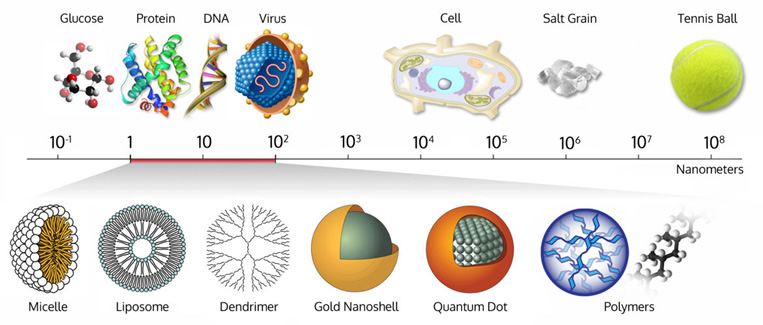Nanotechnology
The Toxicology and Biochemistry Section of the NIOH is contributing to NIOH efforts to support the responsible development of the nanotechnology in South Africa. Nanotoxicology is a sub-specialty of particle toxicology and is dedicated to the study of the toxicity of nanomaterials.
Nanotechnology refers to the branch of science and engineering devoted to designing, producing, and using structures, devices, and systems by manipulating atoms and molecules at nano-scale. A major output of this activity is the development of new materials in the nanometer scale, including nanoparticles, i.e. particulate materials with at least one dimension of less than 100 nanometers (100 millionth of a millimeter) or less. One nanometer is 10-9 m or 10-3 μm, by comparison, by comparison, a human hair is approximately 70,000 nm in diameter, a red blood cell is approximately 5,000 nm wide and simple organic molecules have sizes ranging from 0.5 to 5 nm.

Figure 1: Size comparison in nanometer scale. Image Source: http://www.wichlab.com/nanometer-scale-comparison-nanoparticle-size-comparison-nanotechnology-chart-ruler-2/
Nanotechnology is expected to be the basis of many of the main technological advancements of the 21st century. Research and development in this field is growing rapidly throughout the world. Engineered nanoparticles are widely used for bio-medical applications, particularly for therapeutic and diagnostic use, for example drug delivery, early cancer detection and treatment, bio-imaging and sensing and gene therapy. Environmental uses of engineered particles covers the area of water remediation, pollution control, and harnessing clean energy. In the electrical world they can be applied and used as chips due to their high electrical and optical properties, for example in computers, antennas of televisions and other electrical signals in televisions, radios, phones. They have been developed to reinforce materials of by making them more flexible, durable and resistant to destruction. They are used in making stainless fabrics, long lasting tennis balls, shoes, glasses, rubber and better car tyres.
Owing to their unique nano-scale, nanoparticles are provided with many special and unusual physicochemical properties that raise many concerns about the safety of these materials. Assessment of health risks arising from exposure to chemicals or other substances requires understanding of the intrinsic toxicity of the substance.
The Toxicology Section at the NIOH is involved in both local and international collaborations to assess the safety of engineered nanoparticles. On a local level, substantial support from the Department of Science and Technology (DST) has enabled research projects on the risk assessment of gold nanomaterials, and the creation of a consortium (NIOH/NWU/CSIR/UP) on nanotechnology health, safety and environment (HSE) risk research platform in South Africa. Through this support, the Section has established important methodologies to assess the hazard and also exposure to gold nanoparticles but also to other nanomaterials that are synthesized in South Africa.
Internationally, the Toxicology Section works with the World Health Organization (WHO), the Organization for Economic Co-operation and Development (OECD), and the International Standards Organization (ISO); as well as contributing to the risk assessment of engineered nanoparticles through the European Commission’s Framework Programmes (EU FP7 and EU FP20). These projects at NIOH contribute to guidelines, standards, modelling, and assist in filling the existing knowledge gaps in the understanding of the possible adverse effects of nanotechnologies the examples of which include the publication of the ISO/TR 19057 entitled “Nanotechnologies — Use and application of acellular in vitro tests and methodologies to assess nanomaterial biodurability”, the OECD document ENV/JM/MONO(2016)60 entitled “Gold nanoparticle occupational exposure assessment in a pilot scale facility” and the most recent publication of “WHO Guidelines from Potential Risks on Protecting Workers of Manufactured Nanomaterials”.
